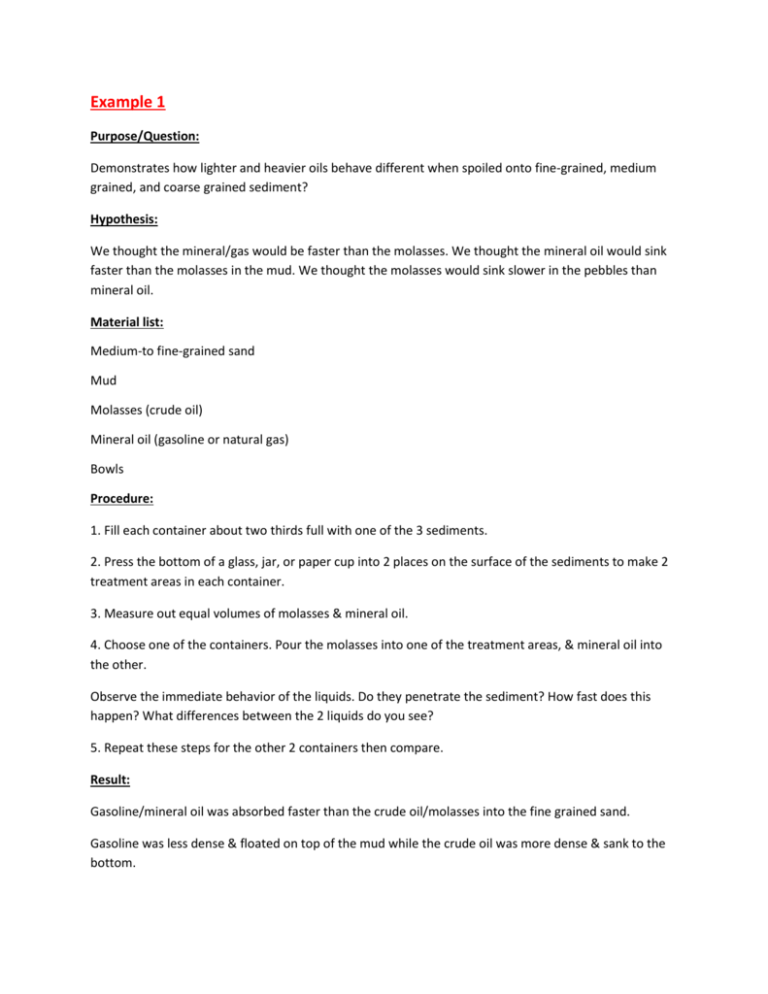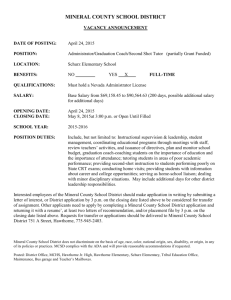Example 1
advertisement

Example 1 Purpose/Question: Demonstrates how lighter and heavier oils behave different when spoiled onto fine-grained, medium grained, and coarse grained sediment? Hypothesis: We thought the mineral/gas would be faster than the molasses. We thought the mineral oil would sink faster than the molasses in the mud. We thought the molasses would sink slower in the pebbles than mineral oil. Material list: Medium-to fine-grained sand Mud Molasses (crude oil) Mineral oil (gasoline or natural gas) Bowls Procedure: 1. Fill each container about two thirds full with one of the 3 sediments. 2. Press the bottom of a glass, jar, or paper cup into 2 places on the surface of the sediments to make 2 treatment areas in each container. 3. Measure out equal volumes of molasses & mineral oil. 4. Choose one of the containers. Pour the molasses into one of the treatment areas, & mineral oil into the other. Observe the immediate behavior of the liquids. Do they penetrate the sediment? How fast does this happen? What differences between the 2 liquids do you see? 5. Repeat these steps for the other 2 containers then compare. Result: Gasoline/mineral oil was absorbed faster than the crude oil/molasses into the fine grained sand. Gasoline was less dense & floated on top of the mud while the crude oil was more dense & sank to the bottom. Analysis/Discussion The molasses represent crude oil and the “crude oil” sank straight down the ocean (mud). Although the “crude oil” sank straight down the ocean (mud), it stayed on the surface when we spilled it on the beach (fine grained sand). So it would be easier to pick it up, if it was on the “beach” then if it was in the “ocean”. The gasoline (mineral oil) did the opposite of the crude oil (molasses). It would be easier if you had to pick up oil on the beach, other than gasoline on a beach. The oil would stay on the surface other than the gasoline. Although it would be harder to pick up crude oil if it was in the ocean. The oil would sink straight down, but the gasoline would float on the top. Conclusion: Even though one another was easier to pick up in different surfaces (ocean & beach). They both still affect the sea life and if there’s no sea life then there’s no SEAFOOD! That means no more fish, shrimp, shark, oysters, lobster, crab, etc. So there’s less food for us humans. Example 2 Title: N/A . Purpose or Question: The purpose of this experiment was to see how lighter and heavier oils behave differetly when spilled onto mud, and medium-to fine-grained sand. Hypothesis: Sand: My partners and I think the molasses is going to say on top longer than the mineral oil. We also think the mineral oil is going to sink faster Mud: My partners and I think molasses going to stay on top, and mineral oil is going to stay on top too Material List / Set-up:(A,B) A. 3 wide-month containers Measuring cup Coarse-grained sand Clay or mud Molasses Mineral oil B. First we added the mineral oil on the sand. Second we added the molasser on the sand. After that we did the same thing but on the mud. Procedure: We made the materials for the lab We made an hypothesis We tested the experiment Then we made an analysis and conclussion Data: N/A Results: Sand- The mineral oil sunk in the sand really fast. While, the molasses stayed on the top of the sand, sinking really slowly. Mud- The mineral oil stayed on top of the mud floating and did not sink at all. Then, when we put some molasses in the mud and it sunked. Analysis / Discussion: We came up with, that it turned out to be a success and that it was an good experiment because it gave us an idea that if natural gases or crude oil and other harmful energies were to get on certaint substances then a solution can be made but if it got on to other substances there cant be an solution made.






